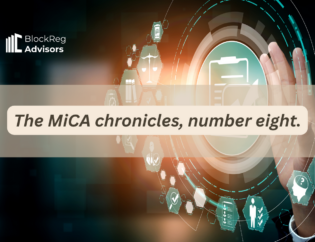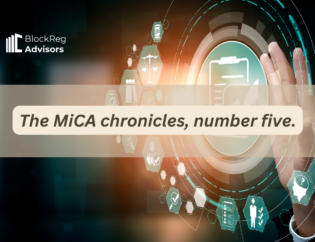

MiCA and the bridge to traditional finance
A lot of the discussion around the prospective impact of MiCA concerns the way it raises the regulatory bar for crypto businesses, be them centralized or decentralized, whatever the latter means in technical and legal jargon (for a really good discussion on MiCA and decentralization, please see Jonathan Galea’s last post in BCAS’s blog). The narrative is simple: crypto firms have been living in a mostly unregulated field for the past years, and now they must prepare to step up their game to comply with a new batch of rules.
In some ways, the approach taken by the EU with MiCA cannot be seen as a bad thing for crypto businesses. This is because MiCA is a legislative act specific for crypto-assets, which shows, to some extent, the EU’s acknowledgement of the singularity and exceptionality of the crypto market and its potential to foster innovation in financial services. There were other paths that EU legislators could have taken: for example, they could have just considered crypto as a new “trend” in finance and set up to amend financial laws on payments and securities, considering that crypto assets were but digital representations of payment instruments, such as e-money, or of financial instruments, such as securities. But instead of imposing traditional finance rules and requirements on its operators, EU legislators looked at crypto-assets and considered the complexity of its market and ended up carving an independent regulatory framework to be applicable to such activities.
However, this approach can also be seen as a mere marketing move. MiCA does not regulate all (and maybe not even the most interesting) commercial activities related to crypto assets, since it excludes DeFi, NFTs, and several other forms of tokens. Furthermore, when considering the activities that it does regulate (for example, issuing of three different types of tokens), it becomes clear that the rules are but a variation of existing EU rules on issuance of securities, licensing of credit and payment institutions, and commercial duties of financial intermediaries, among other. The regime is specifically about crypto, but such regime eventually purports to treat crypto as another form of financial market, under the same principles, rules, and demands. According to policymakers, this is what tech-neutrality is about: same activity, same rules, even if the structure, dynamics, and market logics are different.
Anyhow, a lot of attention goes on what crypto companies and crypto bros have to deal with, but there is another side of the coin that is not talked about enough. I’m referring to the potential impact of MiCA on traditional finance, and how “tradfi” players can come into play in this new form of regulated market.
Tradfi – banks, investment firms, EMIs, PIs, funds, Coca-Cola, you name it – have shown interest in crypto and DLTs for some time, slowly planning integrations (such as Paypal), or developing internal products (such as JP Morgan), or even making use of certain structures to transfer assets (such as BBVA). Non-financial firms have also considered entering the crypto-world, most notably Meta. The lack of clear regulatory settings in Europe made this situation complicated until now, but now that MiCA is in town, it is fair game for everyone – traditional or crypto alike.
I believe that the game-changing moment in crypto will only happen, in terms of commercial adoption and general use, when traditional finance embraces crypto and decides to offer crypto-related products and services. Without traditional finance, there is no chance for the market to grow, for two simple reasons.
The first reason is: market gatekeeping. Banks and investment firms have been around for quite some time already (centuries, actually), and they hold keys that are essential for market access to individuals, firms, and States. Because of their position, they are highly regulated entities, and rightly so, with significant corporate structures that are very difficult to compete with. And, if you want to cash in and go to fiat, who you are going to call, and who can decide if you can have a bank account or not, or a credit? Tradfi is so powerful, in practice, that it is difficult for any significant player to appear without its backing, or at least without its consent.
The second reason is capital. It is what makes the world go around, right? And it is also what tradfi has aplenty, in many forms (cash, equity, debt) and sizes. Capital circulates through tradfi structures, lives through tradfi channels, and its pumped to the world by tradfi decisions and options. Crypto can, at best, provide some alternative options and innovations to the point of becoming one of the many structures of tradfi. But the real capital is still in traditional institutions, and this is unlikely to change in the near to medium future (I also doubt that it will change in the long run, but let’s not get carried away yet).
Does MiCA create any incentive for tradi businesses to enter the crypto market? In some ways, yes. If you are a credit institution, or an EMI, you don’t have to comply with several obligations concerning the issuing of stablecoins, be them asset-reference tokens or e-money tokens. It makes sense: a bank or an EMI is already so regulated and must comply with so many obligations in terms of governance, digital resilience, prudential requirements and the like, that it didn’t need to comply with the requirements MiCA upholds for non-credit institutions. Furthermore, if you are already a financial intermediary (or a bank) you may also provide certain services by simply going to a simplified process of licensing and registration, according to the terms of article 60 of MiCA.
In a nutshell, tradfi entities have a first-mover advantage, in the sense that they are already licensed and regulated, while crypto businesses other than regulated institutions will have to go through licensing procedures before they can operate in the EU.
This does not mean that it will be plain sailing for tradfi to enter the business. They may have the money and the structure, but they lack the expertise and the knowledge to navigate in the complexity of the crypto market, particularly in what concerns making a connection with DeFi protocols. They will certainly have risk aversion to join a market that is still trying to build good foundations for its operations. Additionally, national regulators may force tradfi players to set up clear corporate and structural divisions between their main businesses and their crypto endeavours – to the point of discouraging them altogether if they consider such crypto forays risky. One of the lessons of the economic crisis of 2008 was to never overlook the connection between financial products and credit providing, and regulators have since become more stringent with tradfi entities in this matter.
However, it is difficult not to see the opportunity that is here for tradfi players to shape the industry – or for industry leaders to take the moment to help tradfi players enter the market. The regulatory requirements for exchanges, custodians and issuers will be so many, that only companies with a good capital buffer, a very sophisticated governance structure, enough personnel, or a completely decentralized setting (which is still early to consider what it means) will be able to have the requisites in place and start to offer services. Such companies will most likely be the current big players in the industry, who will fight for maintaining their size in this new financial setting, alongside with their tradfi partners.
Smaller companies may have a chance of developing interesting solutions for niche sectors, and grow alongside such structures, or merge / be acquired by other players and create new market segments. In terms of financial dimension, crypto is still not an important nor very significant market for traditional players to dip in, and this is something that less traditional players may use to gain some advantage while the market is developing. There are also so many areas that MiCA does not cover or that financial firms (particularly in securities’ markets) are not capable of developing that smaller businesses specific to crypto can try to jump in, and establish themselves. However, when tradfi comes to town and starts playing, that’s when we will see how crypto is going to succeed, and how far it can really get.
MiCA is more advantageous to tradfi than to crypto firms, but I think it was not completely intentional: as the Strokes sing, “it’s just the way it is”. The financial sector is subject to such high degrees of regulatory and compliance requirements that, as a director of a major bank once told me, it is very difficult for other players and competitors coming from the fintech side to appear with such capacity to disrupt their business. Crypto firms may have had that advantage prior to regulation. It will be interesting to watch how “trad” crypto will become, or how “crypto” finance will be. Lets see.
Note: This text is the sole work of the author and does not bind BlockReg Advisors Ltd. nor does it constitute legal advice. All rights reserved.
If you want to discuss these topics further do not hesitate in contacting our team at [email protected] and [email protected].








